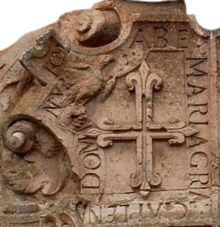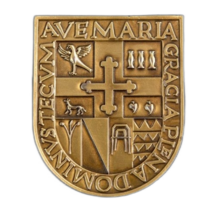|
Juan Vélaz de Medrano y Mauleon
Juan Vélaz de Medrano y Mauleon y Navarra (b. 16th century, Igúzquiza) was a lord, nobleman and knight from the House of Medrano. Juan was the owner of the Palace of Vélaz de Medrano and the hereditary lord of Igúzquiza, Agos, Aguinano, Orendain, Zabala, Arroniz, and 5th lord of Learza[1] during the reign of Charles V, Holy Roman Emperor. Juan Vélaz de Medrano was a descendant of Kings Henry I of Navarre from the House of Blois; Charles II of Navarre from the House of Évreux; and King Philip III of Navarre and Joan II, Queen of Navarre, from the House of Capet (the most senior line of the royal Capetian dynasty).[2] Family Juan Vélaz de Medrano y Mauleon was the seventh of the same name, head of the ancient House of Medrano in Navarre and a direct descendant of Juan Martínez de Medrano, Lord of Sartaguda, Arróniz, etc., second of the name, regent of the Kingdom of Navarre in 1328.[3] Juan Vélaz de Medrano y Mauleon y Navarra was the heir and namesake son of the noble Juan Vélaz de Medrano y Echauz and Ana de Mauleon y Navarra, both descendants of the Kings of Navarre.[4][5] His father Juan made his will and testament on 30 April 1531, and his mother Ana de Mauleon made hers on 4 May 1506.[6] The Medrano family is a very ancient house of noble origin, it is found in different times and in different places. Many principles are attributed to them by authors and historians:
Confirmation of nobilityOn September 1, 1552, Charles V, Holy Roman Emperor, issued the Carta Ejecutoria de Hidalguía to confirm the noble status of the Medrano family. Detailed genealogical records are presented to support the family's claim to nobility and descent from royalty, with records dating back to Juana Pimentel[9] and King Enrique III of Castile and León, hereby proving their status. The document, created in Valladolid and Arenas, Spain, concludes with official signatures and seals, affirming their noble status.[10] Paternal ancestry Juan Vélaz de Medrano y Mauleon's father Juan Vélaz de Medrano y Echauz was the sixth of the same name, baron and Lord of Igúzquiza, Aguinano, Orendain, Zabala, Arroniz, the 4th lord of Learza, merino of the merindad of Estella and the alcaide of the castles of Del Castillo, Santacara, and Monjardin.[11][12] His father was one of the main leaders in the defense of Navarre against the Castilian invasion and was a major knight of King Juan de Albret, who gave him in 1496 the property that belonged to Langarot de Yaniz, who was declared a traitor.[5] Juan Vélaz de Medrano y Mauleon was the nephew of the famous alcaide of Amauir-Maya, Jaime Vélaz de Medrano y Echauz.[13][14][15] Juan was the paternal grandson of Juan Vélaz de Medrano y Goni and Elvira de Echauz y Beaumont. His grandfather Juan Vélaz de Medrano y Goni was the fifth of the name, Lord of Igúzquiza, Agos and Aguinano, the 3rd lord of Learza, and alcaide of the castle of Monjardin. He was a prominent noble and knight during the reign of John III of Navarre and Catherine of Navarre. His grandfather was the son of Ferran Vélaz de Medrano and Elvira de Goni.[16]  Juan's grandmother Elvira de Echauz y Beaumont was the daughter of Carlos de Echauz, 15th Viscount of Baigner and Juana Margarita de Beaumont.[17] Juana Margaret de Beaumont was the daughter of Carlos de Beaumont, the granddaughter of Prince Louis of Navarre, Duke of Durazzo, King of Albania in 1376, and the great-granddaughter of Queen Joan II of Navarre and King Philip III of Navarre, of the house of Évreux, which is a minor branch of the Capetian dynasty.[16] Juan's paternal great-grandfather Ferran Vélaz de Medrano was the Lord of Iguzquiza, the 2nd Lord of Learza, and a ricohombre of Navarre.[18] In 1455, the king gave Ferran Vélaz de Medrano the Pechas de Muez, Mendoza and Legaria as compensation for the two thousand florins he had spent in the conquest of Geneville, and in 1471, he was given the valleys of Allin and Santesteban de la Solana.[19] In 1456, Ferran was the alcaide of the castle of Monjardín, and in 1461, he was the lord of Igúzquiza. In 1471, the king granted him the taxes of the valleys of Allín and Santesteban de la Solana.[20] Ferran rebuilt the Palace of Vélaz de Medrano, which was famous for the splendor of the festivities held by Ferran Velaz de Medrano and his children and grandchildren, which were often attended by the Kings and Queens of Navarre themselves.[21] Juan's great-great-grandfather Juan Vélaz de Medrano was the fourth of the name, lord of Iguzquiza, Arguiñano, Arzoz, Artazu, Zabal, Orendáin, the 1st lord of Learza, founder of the Vélaz de Medrano mayorazgo in 1437 (the oldest in Viana) and the Royal Chamberlain of the Kings of Navarre.[22] Maternal ancestry Juan Vélaz de Medrano's mother Ana de Mauleon y Navarra is the daughter of the ricohombre Landron de Mauleon y Claver and Juana de Navarra y Enriquez de Lacarra, the latter being a great-great-granddaughter of King Charles II of Navarre and a descendant of King Enrique I de Navarra.[4][23] Juana de Navarra y Enríquez de Lacarra is the daughter of Pedro de Navarra y Peralta, III Viscount of Muruzábal and Inés Enríquez de Lacarra y Foxan. Juan Vélaz de Medrano is the great-great-great-great-grandson of King Charles II of Navarre through his son Prince Leonel de Navarra, first Viscount of Muruzábal. The Viscount of Muruzabal takes its name from an old royal manor town called Muruzabal. In 1407, King Charles III of Navarre included it within the viscount created in favor of his brother Prince Leonel de Navarra, I Viscount of Muruzábal, both sons of King Charles II of Navarre. The III Vizcountess consort of Muruzábal Ines Enriquez de Lacarra y Foxan, descendant of King Enrique I de Navarra, is the daughter of Beltran "el Joven" Enriquez de Lacarra y Moncayo, IV Lord of Ablitas. Her father Beltran Enriquez de Lacarra y Moncayo, IV Lord of Ablitas, is the grandson of Martín Enríquez de Lacarra, I Lord of Ablitas; great-grandson of Juan Enríquez de Lacarra, Prince of Navarra; great-great-grandson of Henry I the Fat, king of Navarre and Garaztar de Lacarra. Marriage In 1543, Juan Vélaz de Medrano y Mauleon married Maria de Piñeiro.[1] His wife Maria de Piñeiro y Elio, Lady of Eriete and Ipasate, patron of the company of Jesus in Pamplona and Trapani in Sicily, came from a distinguished Galician family recognized by both ancient and modern genealogists.[24] Maria de Piñeiro was the daughter of Pedro de Piñeiro y Elio, a knight of Santiago who was a prominent leader in the army of the Great Captain and alcaide of Cutron in Italy, and Ana de Dicastillo, Lady of Eriete, and lady to the Queen Germaine of Foix.[1][24] Ana de Dicastillo was the daughter of Juan de Dicastillo, Lord of Eriete and Pasate, and Chief Steward of the Duchess of Brittany.[24] Issues Jeronimo Vélaz de Medrano y PiñeiroJuan Vélaz de Medrano y Mauleon was succeeded by his son and heir Jeronimo Vélaz de Medrano y Piñeiro, Baron and Lord of Igúzquiza, Agos, Aguinaro, Orendain, Zabala, Arroniz, 6th Lord of Learza. Jeronimo Vélaz de Medrano married Isabel de Lapena y Huidobro.[25] Juana Vélaz de Medrano y PiñeiroJuan's daughter Juana Vélaz de Medrano was the wife of Miguel de Goñi y Peralta, a nobleman from the influential Goñi y Peralta family. Her husband passed away in 1576, leaving her widowed. After his death, she was responsible for the welfare of their son, León de Goñi y Peralta, who was a minor at the time. In 1576, Juana Vélaz de Medrano was involved in legal proceedings related to the inheritance of the family estates.[26] She was mentioned in a document before a notary, where it was recorded that she was the mother of León de Goñi y Peralta, the legitimate heir to the palaces of Goñi, Peralta, Bidaurre, and Salinas de Oro. The document also mentions her late husband, Miguel de Goñi, and refers to her son as the successor to these significant family estates.[26] In 1578, Juan's daughter Juana Vélez de Medrano is noted in another document, where she is referred to as the widow of Miguel de Goñi y Peralta and the mother of León de Goñi y Peralta, her only son. This document concerns a power of attorney for assets left behind by the deceased León de Goñi y Peralta, the archdeacon, confirming her role in managing her family’s property after both her husband’s and son’s deaths.[26] Legal casesFrom 10 October 1533 to 23 December 1535, Don Juan Velaz de Medrano y Mauleon and his relative Tristan de Mauleon, Lord of Rada and Traibuenas, filed a legal case in the high court of Navarre over possession of the depopulated places of Abaiz (Lerga) and Aldea (Lerga) and the mill of Caparroso.[27] From February 21, 1567, to August 21, 1568, in Learza and Orendain (Guirguillano), Navarre, Spain, Maria Piñeiro initiated a legal action against her husband, Juan Velaz de Medrano y Navarra, lord of Learza and Orendain, concerning the authorization to donate 1,000 ducats from her dowry to their son, Jeronimo Velaz de Medrano y Piñeiro.[28] From March 17, 1575, to January 28, 1605, a legal dispute unfolded involving the place of Igúzquiza and his son Jeronimo Velaz de Medrano y Piñeiro. The case also involved Pedro de Allo and his servants, as well as Diego de Huidobro and Sebastiana Velaz de Medrano y Lapeña, lords of the Igúzquiza palace and residents of Estella.[29] The dispute centered on several issues, including a prohibition on new construction at the parish church of San Andrés de Igúzquiza, the nullification of possession rights and honors related to the church, opposition to the collection of penalties for butchering, and compliance with local regulations. Additionally, the counterclaim involved asserting possession of these rights based on their nobility and status as lords of the Palace of Vélaz de Medrano.[29] Between March 19, 1576, and November 6, 1576, in various locations including Learza, Orendain (Guirguillano), and Pamplona (Iruña) in Navarre, Spain, a legal dispute occurred involving his son Jeronimo Velaz de Medrano y Piñeiro y Navarra, lord of Learza and Orendain, and Ana Hernandez de Sada, widow of Pedro de Abaiz.[25] The conflict also included Jeronimo de Abendaño y Olleta, Ana's son-in-law, and Ana de Abaiz, his wife, who were residents of Pamplona. The issue at hand was the execution of assets to recover 100 ducats, which was part of a larger claim involving a total of 300 ducats related to a previous decree and acknowledgment of debt.[25] References
|
||||||||||||||||||||
Portal di Ensiklopedia Dunia
